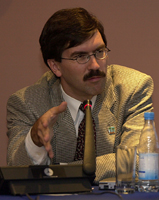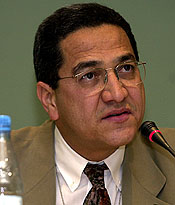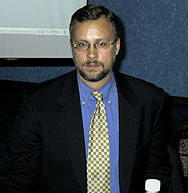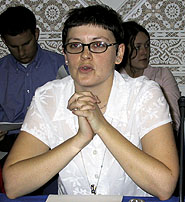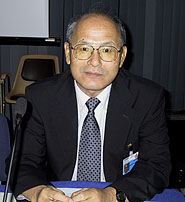|
|
|||||||||||||||||||||||||||||||||||||||||
|
|||||||||||||||||||||||||||||||||||||||||
|
Events convened on Monday, 5 November 2001 |
|
Forestry projects: How to credit and monitor
Presented by the Organisation for Economic Cooperation and Development (OECD)
Gareth Phillips, Societé Générale de Surveillance (SGS), provided an overview of SGS' risk and uncertainty assessments in sinks projects. SGS' assessments define quantitative risks and uncertainty in terms of a percentage discount to predicted emission reductions or sequestration. Phillips underscored that risk assessments should be repeated over time as uncertainty decreases so that more credits can be made available. John Kadyszewski, Winrock International, introduced Winrock International's work on measuring and monitoring LULUCF projects. He said field experience suggests that the initial cost of monitoring can be less than US$0.25 per ton of carbon, and that risk should be managed with insurance methods. He noted that the risk of carbon loss can be incorporated into the carbon-crediting process, and that new imagery tools allow enhanced monitoring of natural and human-induced disturbances. Discussion: One participant noted that most LULUCF projects do not measure soil carbon because the levels of soil carbon do not increase. Another participant highlighted that contradicting evidence also exists.
|
|
The CDM and emissions reductions in Brazil Presented by the Brazilian delegation
Rui Fonseca, Petrobras, described Petrobras' strategy for incorporating sustainable development strategies into its business. He highlighted environmental and social responsibility programmes undertaken by Petrobras, including forest preservation, education, and emissions reduction projects. Laura Tetti, JZL Consultoria, explained that Brazil produces 300 million tonnes of sugar each year, more than half of which is used to produce ethanol. She explained that an increase of 500 million liters of ethanol per year would fuel 100,000 vehicles and generate 20,000 direct jobs and 60,000 indirect jobs. She highlighted that: sugar cane bagasse can also be used for electricity production; the sugar cane sector is fully self-sufficient in terms of electric power; and by 2004, an additional 3,000 megawatts of power will be produced from sugar cane bagasse. Cícero Antonio Lima, Companhia Vale do Rio Doce, described a project that involves the substitution of fast-growing, cloned trees for coal in the production of foundry pig iron. He highlighted the resulting GHG emissions reductions and job creation benefits. Luiz Gylvan Meira Filho, Brazilian Ministry of Science and Technology, described the Interministerial Commission on Climate Change, which helps to formulate Brazil's negotiating position at the climate change negotiations. It is responsible for granting approval to CDM projects based on a set of national sustainability criteria.
|
|
National registries for a future greenhouse gas emissions trading scheme: The approaches of France and the UK Presented by the International Emissions Trading Association
Kedin Kilgore,
Natsource, stated that registries should be broad, uniform, accessible,
public, dynamic, and mandatory. He described the allowance tracking
system of the US Environmental Protection Agency's Acid Rain Division,
which uses serial numbers to allow the tracking of each allowance's
trading history, and records and posts all transfers on the internet.
He also outlined the UK registry, which will use unique serial
numbers comprised of year of issue, commitment period, information
of origin, and identification number, and will exist as an electronic
database.
|
|
How to kick-start the CDM process Presented by Helio International
Lubinda Aongola,
Zambia, addressed the institutional framework needed to support
the CDM. He outlined the terms of reference for CDM sub-committees
and technical secretariats. He underscored the need to formalize
the CDM sub-committees into designated national authorities for
the CDM. Youba Sokona,
Environment and Development Action in the Third World (ENDA-TM),
explained that one objective of CDM-Susac, a project which aims
to introduce mechanisms to ensure that Africa, Caribbean and Pacific
(ACP) countries are not left behind in the CDM, is to explore
conditions under which CDM projects will be implemented in participating
countries. He underscored the need for substantial efforts to
start CDM projects in ACP countries, and the importance of capacity
building in technology and methodology. Emilio La Rovere, Brazil, introduced the SouthSouthNorth (SSN) project, whose mission is to design, develop and implement CDM projects. He explained that SSN's work involves developing project eligibility criteria and sustainability indicators. Eligible projects include energy activities qualifying for the CDM, and sustainability indicators include the project's contribution to local sustainability and technological self-reliance. Mike Bess, Energy for Sustainable Development Ltd. (ESD), outlined the costs and risks involved in investing in CDM projects, and presented the scope for CDM projects in ACP countries. He explained that prerequisites for attracting investors include environmental additionality and government support.
|
|
Compliance, monitoring and verification requirements for a credible and environmentally effective Kyoto emissions trading system Presented by the World Wildlife Fund (WWF) and the International Emissions Trading Association (IETA) Andrei Marcu, IETA, stressed the need for a robust emissions trading system that both promotes environmental integrity and benefits businesses.
Mark Weintraub,
Shell International B.V., stated that Shell is interested and
committed to having market mechanisms play an important role in
the Protocol, as they lower costs and offer a critical source
of capital for investments in new technology. He stressed the
need for emissions trading systems to have environmental credibility
and integrity, high liquidity, low transaction costs, entity-to-entity
trading, and fungibility, and for national registries to be clear,
workable, transparent, and consistent across countries. Molly Anderson, Verification Research, Training and Information Centre (VERTIC), explained VERTIC's experience with implementing verification systems for a range of international treaties. She highlighted the importance of current negotiations on Articles 5 (methodological issues), 7 (communication of information), and 8 (review of information), which will be critical for determining whether the Protocol is working properly. Mark Kenber, WWF, explained that most NGOs favor emissions trading, provided that it delivers environmental effectiveness in terms of reducing emissions. He noted that decisions taken at COP-7 will go a long way toward determining the credibility of emissions trading, and stressed the need for: an enforceable and binding compliance regime that does not set an artificially low price cap; real-time access to information contained in registries, including the source of credits and project information; stakeholder consultation mechanisms; and guarantees that allowances represent real and verifiable emissions reductions. Gareth Phillips, SGS, stated that if banking of Removal Units is allowed, it could challenge the environmental integrity of the Kyoto Protocol, whereas if such banking is restricted, it could create an undesirable trade barrier.
|
|
The equity agenda Presented by Friends of the Earth International
Tuuli Lehtinen and Jenni Kauppila, Friends of the Earth (FOE) Finland, introduced a report entitled "The Whole Climate: Climate Equity and its Implications for the North." The report examines three proposals that attempt to factor equity into emissions allocations: the Brazilian proposal, which takes historic emissions into account and sets a 30 percent reduction target of 1990 levels by 2020 for Annex I countries; the Pew Center on Global Climate Change's proposal, which uses standard of living, responsibility and opportunity criteria to divide countries into three groups -- "must act now," "should act now, but differently," and "could act now;" and the Global Commons Institute's contraction and convergence model, which requires that emissions be reduced gradually, eventually reaching 60 percent of current emissions, and that countries reach equal per capita emissions levels by 2045. Douglas Korsah-Brown, FOE Ghana, noted that, because the UNFCCC lacks a definite emissions cap, countries will continue to consume and will leave no environmental space for countries that are still developing. He stressed the need for an emissions cap to allow these countries to increase their emissions, and for capacity building and technology transfer to enable developing countries to raise their consumption and living standards to basic levels. Paul Baer, Eco Equity, explained that Eco Equity was founded to educate American citizens about the equity issues surrounding the global climate debate and the ethical and human rights imperatives for allocating emissions on a per capita basis.
|
|
Climate policy dialogue in Asia Presented by the Institute for Global Environmental Strategies (IGES) Naoki Matsuo, IGES, summarized the outcomes of a series of IGES-sponsored climate policy workshops held throughout Asia, where consensus emerged that CDM projects should consist of collaborations that maximize opportunities for both the host country and investors.
Sung Hwan Son, Republic of Korea, discussed barriers to participation of least developed countries (LDCs) in the global climate dialogue. He noted that the US' recent rejection of the Kyoto Protocol, a perceived lack of priority on climate issues by other Northern governments, and low emphasis on technology transfer are disincentives for LDCs to dedicate scarce resources to climate change issues. He stressed the need for capacity building and technology transfer to ensure LDC support, and for the issue of equity to be fully explored in future climate discussions. Michael Grubb, Imperial College Environmental Policy and Management Group, stated that from a European perspective, the degree of international cooperation in Asia is encouraging and comforting. He said it now appears that the Kyoto Protocol will be ratified, and that it was imperative for Annex I countries to quickly gain experience in the Protocol's implementation. He flagged access to sustainable energy as an issue that could bring climate change to the table at the World Summit on Sustainable Development. He underscored the need for both technological and policy innovation within countries and at multilateral climate change negotiations.
|
|
For
further RealVideo coverage of these and other side-events at COP-7,
please visit the UNFCCC's "On Demand" webcast page |
|
| The Earth Negotiations Bulletin (ENB) on the side is a special publication of the International Institute for Sustainable Development (IISD) in cooperation with the United Nations Framework Convention on Climate Change (UNFCCC) Secretariat. The Editor of ENB on the side is Kira Schmidt <kira@iisd.org>. This issue has been written by Fiona Koza <fiona@iisd.org>, Dagmar Lohan <dagmar@iisd.org>, and Kira Schmidt <kira@iisd.org>. The Digital Editors are Andrei Henry <andrei@iisd.org>, Leila Mead <leila@iisd.org> and Kenneth Tong <ken@iisd.org>. Funding for publication of ENB on the side at COP-7 is provided by the UNFCCC Secretariat. The opinions expressed in ENB on the side are those of the authors and do not necessarily reflect the views of IISD and funders. Excerpts from ENB on the side may be used in non-commercial publications only and only with appropriate academic citation. For permission to use this material in commercial publications, contact the Managing Editor at <kimo@iisd.org>. Electronic versions of these issues of ENB on the side from COP-6 Part II can be found on the Linkages WWW server at http://enb.iisd.org/climate/cop7/enbots/. | |
|
|
| © 2001, IISD. All rights reserved. |
|




